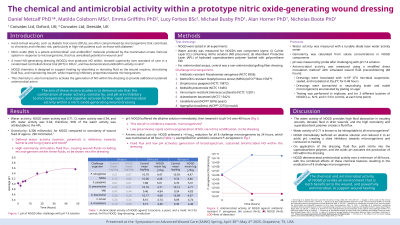Laboratory Research
(LR-003) The Chemical and Antimicrobial Activity Within a Prototype Nitric Oxide-generating Wound Dressing
Friday, May 2, 2025
7:45 PM - 8:45 PM East Coast USA Time

Matilda Coleborn, BSc – Research Scientist, Microbiology, Convatec; Emma Griffiths, BSc – Laboratory Supervisor, Microbiology, Convatec; Lucy Forbes, BSc – Scientist, Microbiology, Convatec; Daniel Metcalf, PhD – Director, Advanced Wound Care R&D, Convatec Ltd
Introduction: Hard-to-heal wounds, such as diabetic foot ulcers, are highly prevalent and place a significant burden on patients and healthcare systems. The aim of these studies was to demonstrate the novel chemical properties (defined water activity and pH), and antimicrobial activity from the supplemental generation of nitric oxide (NO), within a novel prototype NO-generating wound dressing*.
Methods: Water activity (relative humidity) of the entire dressing, and for each of the two dressing layers, was measured using a water activity meter. The pH of the dressing was measured using a pH surface probe by challenging dressings with a pH 7.4 buffered solution at 0.4 mL/hour over 48 hours. The antimicrobial activity of the dressing over 48 hours was measured using a direct inoculation method, including a 48-hour preconditioning period, with six bacteria, one yeast, and one mold.
Results: The NO-generating dressing* had a water activity of 0.71 ± 0.014, with 90% of the water activity attributable to the upper absorbent layer. The NO-generating dressing* buffered the alkaline challenge solution immediately and then consistently to pH 5-6 over 48 hours. All challenge microorganisms were rapidly killed by >4 log10 within the NO-generating dressing*.
Discussion: The water activity of the prototype NO-generating dressing* provides high fluid absorption and is inhospitable to absorbed challenge microorganisms. The dressing immediately buffered the alkaline solution back to acidic pH, creating an acidic state that is inhibitory towards microorganisms and conducive to wound healing. This acidic pH also activates the production of NO within the dressing. NO provides additional antimicrobial activity over a minimum of 48 hours, as shown by the eradication of 8 challenge microorganisms. The chemical and antimicrobial activity of the prototype NO-generating dressing* provides a potent antimicrobial environment to potentially support wound healing.
Methods: Water activity (relative humidity) of the entire dressing, and for each of the two dressing layers, was measured using a water activity meter. The pH of the dressing was measured using a pH surface probe by challenging dressings with a pH 7.4 buffered solution at 0.4 mL/hour over 48 hours. The antimicrobial activity of the dressing over 48 hours was measured using a direct inoculation method, including a 48-hour preconditioning period, with six bacteria, one yeast, and one mold.
Results: The NO-generating dressing* had a water activity of 0.71 ± 0.014, with 90% of the water activity attributable to the upper absorbent layer. The NO-generating dressing* buffered the alkaline challenge solution immediately and then consistently to pH 5-6 over 48 hours. All challenge microorganisms were rapidly killed by >4 log10 within the NO-generating dressing*.
Discussion: The water activity of the prototype NO-generating dressing* provides high fluid absorption and is inhospitable to absorbed challenge microorganisms. The dressing immediately buffered the alkaline solution back to acidic pH, creating an acidic state that is inhibitory towards microorganisms and conducive to wound healing. This acidic pH also activates the production of NO within the dressing. NO provides additional antimicrobial activity over a minimum of 48 hours, as shown by the eradication of 8 challenge microorganisms. The chemical and antimicrobial activity of the prototype NO-generating dressing* provides a potent antimicrobial environment to potentially support wound healing.

.jpg)